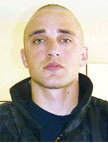
Features
Health and wellness
Hot topics
Fit for Life: Keeping a balanced body
Keeping a balanced body
December 14, 2007
By Aaron Brouwer
 This is part two of a three-part series focusing on exercises to maintain your current physical state and/or improve it. The focus of this article will be the lower body.
This is part two of a three-part series focusing on exercises to maintain your current physical state and/or improve it. The focus of this article will be the lower body.
How much can you bench press? How big are your arms? Nice six-pack! We need to keep a balanced body. We tend to focus so much on upper body strength that we forget about the legs. True, many of the jobs we do as firefighters deal with upper body strength. But we need to have a good balance on the lower body to give us the stability needed to perform these demanding tasks. There are also many fireground tasks that require a strong lower body, like pulling a charged hoseline or climbing up a flight of stairs while carrying a high-rise pack.
Let’s review the basic resistance training guidelines:
• If using free-weights, always lift with a partner (spotter).
• Perform the exercise correctly. If you do not know how to do it properly, ask an expert. Use proper technique.
• Use progression. Do not start out at the heaviest weight; work your way up, so that you finish on your heaviest weight.
• Never lift more than you normally can.
• Avoid alcohol and medications that cause drowsiness prior to working out.
• Remember to breathe. Don’t hold your breath while lifting weights.
• Drink lots of water.
Here are five exercises that will help maintain or improve your lower body strength:
Seated Leg Press: Works the quadriceps, hamstrings, glutes and calves. These muscles are used when climbing stairs, raising a ladder, dragging a charged hoseline and performing a rescue.
Feet should be shoulder-width apart on push platform. Knees should be flexed at 90 degrees. Push weight up while exhaling. Do not lock your knees. Keep knees and feet in a straight line. Lower weight to 90 degrees while inhaling.
Dumbbell Squats: Works the glutes, quadriceps, hamstrings and calves. These muscle are used when climbing stairs, raising a ladder, dragging a charged hoseline and performing a rescue.
Stand with feet shoulder width apart. Step forward about 26 inches with one foot. Keep your back straight with arms down at your side. Slowly bend both legs. Lower yourself until the back knee barely touches the floor.
Forward leg should remain vertical through motion with knee directly over ankle. Return to starting position and repeat with opposite legs. Inhale when lowering and exhale when pushing back to starting position.
Leg Extension: Works the quadriceps. These muscles are used when climbing stairs, raising a ladder, dragging a charged hoseline and performing a rescue. This exercise should not be performed if you have undergone reconstructive knee surgery.
Adjust machine so that back of knees are against pad. Extend knees. Do not lock your knees. Slowly lower weight to starting position. Exhale while pushing weight and inhale when lowering weight. Keep back straight. Do not flex or extend your feet.
Leg Curls: Works the hamstrings. These muscles are used when climbing stairs, raising a ladder, dragging a charged hoseline and performing a rescue.
Lie flat on machine with top of knees just off the pad. Ankle roller should be above the heels. Flex knees until ankle roller reaches your buttocks. Keep hip and stomach down on pad at all times. Slowly lower the weight to starting position. Inhale while pulling weight up and exhale while lowering weight down.
Swimmers: Works lower back and glutes. This muscle is used when climbing stairs, raising a ladder, dragging a charged hoseline and performing a rescue.
Lie face down on ground with feet together. Place arms straight out in front of you. Move one arm and opposite leg up at the same time. As you return to starting position, lift up the other arm and leg. Continue alternating and remember to breathe through exercise.
Don’t race through exercises
Legs have a very large and dense muscle group and therefore they require several sets to properly train them. Do not race through your exercises. Training should be a slow continuous motion, keeping the resistance on the muscle as long as possible. Shake your muscle out between sets to keep blood flow to muscles during rest periods. Joints are the most susceptible to injuries. Be sure to get full range of motion but never lock a joint, especially the knees.
We have all seen the guy who is extremely muscular up top with tiny toothpicks for legs. It is important to train both upper and lower body, keeping a balanced body. Having a balanced body will increase your overall power, strength and speed. It is your duty to your community to maintain excellent physical fitness levels. Not only are their lives depending on it, so is yours.
Aaron Brouwer has 16 years of combined experience in structural and wildland fires. A graduate of Trinity Western University with a Bachelors of Human Kinetics, he is Deputy Chief of Canwest Fire, based in Kelowna, B.C.
Print this page
Advertisement
- Life saved: Firefighters recognized for reviving man after heart attack
- Leadership: The right tool for the right job